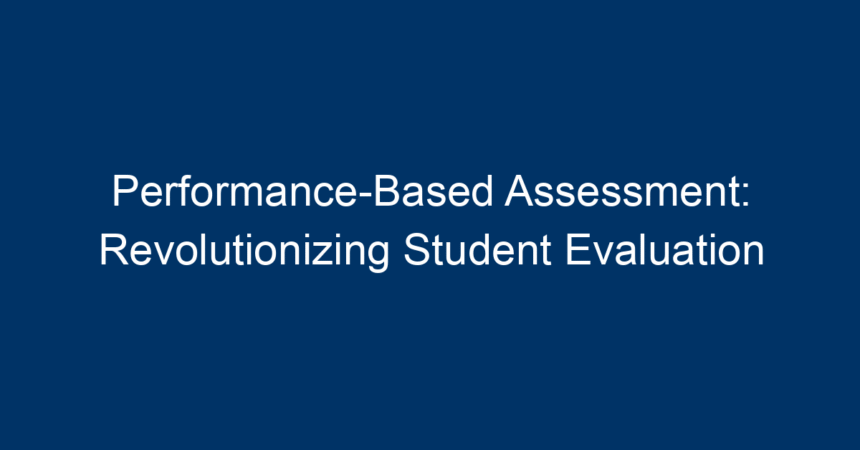In an ever-evolving education landscape, traditional methods of assessing student learning are giving way to innovative practices that prioritize actual student performance over rote memorization. Performance-based assessment is at the forefront of this transformation, offering a more comprehensive and accurate picture of student capabilities. In this article, we’ll explore what performance-based assessment entails, its benefits, challenges, and practical implementations that can enhance educational outcomes.
What is Performance-Based Assessment?
Performance-based assessment refers to evaluation methods that require students to demonstrate their knowledge and skills through real-world tasks. Unlike standard tests that focus primarily on multiple-choice questions or short-answer formats, this approach allows learners to engage more deeply with the material. Through projects, presentations, and collaborative tasks, students showcase their abilities and apply what they’ve learned.
Key Features of Performance-Based Assessment
-
Authentic Tasks: The assessments mirror real-world challenges students might face in their careers or everyday life.
-
Complexity and Depth: Instead of testing basic recall, performance-based assessments assess higher-order thinking skills, such as analysis, synthesis, and evaluation.
-
Collaboration and Interactivity: Many performance-based assessments encourage group work, facilitating critical soft skills like teamwork and communication.
- Continuous Feedback: Teachers provide ongoing feedback throughout the assessment process, allowing for refinement and improvement.
Benefits of Performance-Based Assessment
1. Enhanced Engagement
Students often find performance-based assessments more engaging and relevant than traditional tests. By working on projects they find meaningful, they are motivated to put forth their best effort, resulting in a deeper understanding of the content.
2. Development of Critical Skills
This assessment method fosters essential skills that students will need in their future careers. Creativity, critical thinking, problem-solving, and collaboration are some of the competencies nurtured through performance-based tasks.
3. Holistic Evaluation
Performance-based assessments offer a well-rounded view of a student’s abilities, capturing skills that standardized tests may overlook. Educators can evaluate a student’s creativity, effort, and application of knowledge in unique contexts.
4. Flexible Learning Opportunities
Performance-based assessments can accommodate diverse learning styles and preferences. Students can approach a task in various ways, utilizing their unique strengths, which enhances their learning experiences.
5. Real-World Relevance
By tying assessments to authentic tasks, learners can better see the relevance of their education in the context of real-life scenarios, which can increase retention of knowledge and skills.
Challenges of Performance-Based Assessment
Even though performance-based assessments offer numerous advantages, they are not without challenges.
1. Time-Consuming
Create, administer, and evaluate performance-based assessments can be more time-consuming than traditional testing methods. Teachers must plan carefully and allocate enough time for both the assessment process and feedback.
2. Subjectivity in Grading
Evaluating performance-based assessments can be subjective. Establishing clear rubrics and criteria is essential to ensure fairness and consistency in grading.
3. Resource Intensive
Certain performance tasks may require specific resources or materials, potentially straining school budgets or facilities.
4. Teacher Training Needs
For effective implementation, teachers may need additional training or professional development to effectively design and assess performance-based tasks.
Implementing Performance-Based Assessment in the Classroom
1. Define Clear Objectives
Before implementing a performance-based assessment, it’s crucial to establish clear learning objectives. What skills or knowledge should the assessment measure? Aligning the assessment with curriculum goals ensures relevance and clarity in expectations.
2. Design Authentic Tasks
Create assessments that reflect real-world challenges relevant to your subject area. Tasks could include project proposals, simulations, or presentations. The more authentic the task, the more likely students are to engage meaningfully.
3. Develop a Rubric
A well-defined rubric is essential for objective grading. Clearly outline the criteria and performance levels to minimize subjectivity. Share this rubric with students before they start the task so they understand what’s expected.
4. Foster Collaboration
Incorporate group projects to foster collaboration among students. Encourage them to share ideas and build off each other’s strengths, as teamwork mirrors real-world workplace dynamics.
5. Provide Feedback
Ongoing feedback is a vital component of performance-based assessment. Use formative assessments throughout the project to guide students and help them refine their work. Timely feedback enhances learning and encourages a growth mindset.
6. Reflect and Revise
After the assessment is complete, engage students in reflective discussions. What did they learn? What challenges did they face? Encouraging reflection allows students to internalize their learning experiences and improve future performance.
Case Studies and Examples
Example 1: A Science Class Investigation
In a high school science class, students are tasked with designing an experiment to test a hypothesis related to renewable energy. Rather than a written test, students must present their findings to the class, highlighting their methodology, results, and implications for sustainability.
Example 2: A History Project
In a social studies class, students work in teams to create a documentary about a historical event. They must research, script, and record their documentary, engaging in roles such as researcher, scriptwriter, and filmmaker. This project not only assesses their knowledge of history but also evaluates their collaboration and presentation skills.
The Future of Performance-Based Assessment
As education continues to evolve, performance-based assessments will play an increasingly critical role in student evaluation. By prioritizing skills development over rote memorization, educators can prepare students for a dynamic workforce and a rapidly changing world.
Embracing Technology
With technological advancements, tools like digital portfolios, online collaboration spaces, and video presentations are becoming integral to performance-based assessments. These innovations allow students to create, share, and receive feedback on their work more efficiently.
Scaling Implementation
To effectively implement performance-based assessments on a broader scale, schools will need to ensure adequate teacher training and resource allocation. Sharing success stories and strategies among educators can help foster a community of practice dedicated to enhancing student evaluation.
Conclusion
Performance-based assessment is revolutionizing the way we evaluate student learning, moving away from outdated methods and focusing on real-world skills and competencies. By enhancing engagement, promoting critical skills, and providing a holistic view of student capabilities, this assessment model is paving the way for more meaningful learning experiences.
Educators, administrators, and policymakers must work together to overcome the challenges associated with performance-based assessments, ensuring that all students receive equitable evaluation opportunities. By embracing this innovative approach, we can prepare students not just for tests, but for life’s challenges ahead.
Actionable Insights
- Start Small: Implement one performance-based assessment in your curriculum and gather feedback from students.
- Continuous Learning: Engage in professional development focused on performance-based assessment practices.
- Collaboration: Network with fellow educators to share strategies and resources for successful implementation.
- Reflect and Adjust: After each assessment, reflect on the outcomes and adjust your methods to improve future performance evaluations.
By adopting and advocating for performance-based assessment, educators can significantly enhance student learning and contribute to a more comprehensive educational framework.




